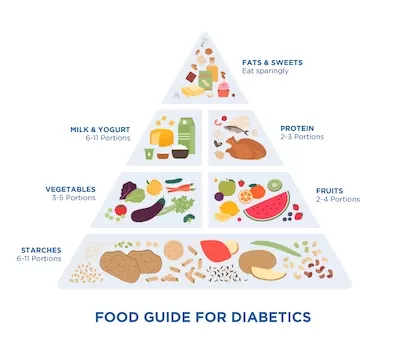Diabetes is a chronic condition that affects millions of people worldwide. Managing diabetes requires careful attention to various factors, and one of the most critical aspects is understanding how carbohydrates impact blood sugar levels. Carbohydrates are a fundamental part of our diet, but for individuals with diabetes, knowing how to incorporate them wisely is crucial. In this comprehensive guide, we will delve into the relationship between carbohydrates and diabetes, providing you with the knowledge and tools you need to make informed dietary choices and manage your condition effectively.
The Basics of Carbohydrates
Carbohydrates are one of the three macronutrients, along with proteins and fats, and they play a significant role in providing our bodies with energy. They are found in various foods, including grains, fruits, vegetables, and dairy products. When consumed, carbohydrates are broken down into glucose (sugar) in the bloodstream, which our cells use for energy.
Glycemic Index (GI)
The glycemic index is a scale that measures how quickly carbohydrates in a particular food raise blood sugar levels. Foods with a high GI are rapidly digested and cause a quick spike in blood sugar, while those with a low GI are absorbed more slowly, resulting in a gradual and steady increase in blood sugar.
Impact on Blood Sugar
It's essential to pay attention to the type and amount of carbohydrates consumed, regardless of the kind of carbs and diabetes type. High-GI foods, such as sugary snacks and white bread, can lead to sudden spikes in blood sugar levels, which can be dangerous. On the other hand, low-GI foods, like whole grains, legumes, and non-starchy vegetables, have a more favorable impact on blood sugar, promoting better control.
Net carbs and diabetes: how much can you consume?
There is no one-size-fits-all answer to how many carbs you should eat if you have diabetes. The amount of carbs you need depends on several factors, such as:
- Your age
- Your weight
- Your activity level
- Your medication
- Your personal preferences
- Your blood sugar goals
According to the American Diabetes Association (ADA), most people with diabetes should aim for about 45% of their daily calories from carbs. This means that if you eat 2,000 calories daily, you should get about 900 calories or 225 grams of carbs from your food and drinks.
However, some people may benefit from eating fewer or more carbs depending on their individual needs and preferences. For example, some people may find that eating fewer carbs helps them lower their blood sugar levels and reduce their medication doses. Others may find that eating more carbs helps them prevent low blood sugar episodes and improve their energy levels.
The best way to find out how many carbs per meal for diabetics is to work with your doctor or dietitian. They can help you determine your carb needs based on your medical history, lifestyle, and goals. They can also teach you how to count carbs using food labels, measuring tools, or apps. It can also be useful to refer to a carb chart for diabetics like the one below.

Which carbs can a diabetic eat?
Not all carbs are created equal. Some carbs can raise your blood sugar faster and higher than others. These have a high glycemic index (HGI). Examples of high GI carbs include white bread, white rice, white potatoes, sugary drinks, candy, and cookies.
Other carbs can raise your blood sugar slower and lower than others. These have a low glycemic index (LGI). Examples of low GI carbs include whole wheat bread, brown rice, sweet potatoes, oatmeal, beans, lentils, fruits, vegetables, and milk.
Low GI carbs are better for diabetes because they don't spike your blood sugar as much as high GI carbs. They also tend to have more fiber, vitamins, minerals, and antioxidants than high GI carbs. Fiber is especially beneficial for diabetes because it helps slow down the digestion and absorption of glucose, making you feel fuller longer, and lowering your cholesterol levels.
Therefore, if you have diabetes, you should choose low-GI carbs over high-GI carbs most of the time. You should also limit your intake of added sugars, such as those found in sodas, juices, candy, and desserts. Added sugars provide empty calories and no nutritional value.
They can also increase your risk of weight gain, tooth decay, and heart disease.
Meal planning for diabetics
Planning your meals and snacks is an important part of managing your diabetes and carb intake. A good way to plan your meals and snacks is to use the plate method. The plate method is a simple tool that helps you balance your portions of carbs, protein, and non-starchy vegetables on your plate.
Here's how to use the plate method:
- Fill half of your plate with non-starchy vegetables, such as salad greens, broccoli, carrots, tomatoes, cucumbers, or mushrooms. These foods are low in carbs and high in fiber, vitamins, and minerals. They also add color and flavor to your meal.
- Fill one-quarter of your plate with lean protein, such as chicken, fish, eggs, tofu, or cheese. These foods are low in carbs and high in protein, which helps you build and maintain muscle mass and keep you satisfied.
- Fill the remaining quarter of your plate with a low GI carb, such as whole wheat bread, brown rice, sweet potato, oatmeal, beans, or lentils. These foods are high in carbs and fiber, which provide you with energy and help control your blood sugar levels.
- Add a small piece of fruit or a cup of low-fat milk or yogurt to your meal if you want. These foods are also high in carbs and fiber, but they also contain natural sugars that can raise your blood sugar levels. Therefore, you should limit your portions and choose fresh or frozen fruits over dried or canned fruits. You should also choose low-fat or fat-free dairy products over full-fat ones.
You can use the plate method for breakfast, lunch, and dinner. You can also use it for snacks, but you may need to adjust the portions depending on your hunger and blood sugar levels. For example, you may have a small apple with a handful of nuts or a slice of whole wheat bread with peanut butter.
See how the plate method works:
Counting Carbohydrates
Carbohydrate counting is a valuable tool for people with diabetes. It involves monitoring the number of carbohydrates in your meals and adjusting insulin doses or medication accordingly. Knowing how to read food labels and estimate portion sizes is essential for accurate carbohydrate counting.
Meal Planning
Creating a well-balanced meal plan is crucial for managing diabetes. Focus on including a variety of nutrient-rich, low-GI foods in your diet. This can help maintain stable blood sugar levels throughout the day. A registered dietitian can provide personalized guidance on meal planning to suit your specific needs.
Discover a healthy diabetic plan here.
The Role of Fiber
Fiber is a type of carbohydrate found in plant-based foods. It is not digested like other carbohydrates and does not raise blood sugar levels. In fact, fiber can help stabilize blood sugar by slowing down the absorption of glucose. Incorporating fiber-rich foods, such as whole grains, nuts, and vegetables, into your diet can be beneficial for diabetes management.
Include carbs carefully
Carbs are an important part of a healthy diet for people with diabetes, but they also affect blood sugar levels. Therefore, it's important to know how many and what type of carbs to eat to keep blood sugar levels within a healthy range. Generally speaking, most people with diabetes should aim for about 45% of their daily calories from carbs, but this may vary depending on individual factors. Low GI carbs are better than high GI carbs for diabetes because they don't spike blood sugar as much and provide more nutrients. The plate method is a useful tool to plan balanced meals and snacks that include the right portions of carbs, protein, and non-starchy vegetables.
FAQS
Q: Can I eat carbs if I have diabetes?
Yes, you can eat carbs if you have diabetes. Carbs are an essential part of a healthy diet, and they provide you with energy and nutrients. However, you need to be careful about how much and what type of carbs you eat, as they can affect your blood sugar levels. You should aim for about 45% of your daily calories from carbs, but you may need more or less depending on your individual needs. You should also choose low GI carbs over high GI carbs most of the time and limit your intake of added sugars.
Q: How do I count carbs if I have diabetes?
Counting carbs is a way of keeping track of how much carbs you eat and drink. It can help you manage your blood sugar levels and adjust your medication doses if needed. To count carbs, you need to read food labels, measure your portions, or use apps or websites that provide carb information for different foods and beverages. You also need to know how many grams of carbs you should eat per day and per meal or snack. Your doctor or dietitian can help you determine your carb needs and teach you how to count carbs.
Q: What are some examples of low GI and high GI carbs?
Low GI carbs are foods that raise your blood sugar slower and lower than high GI carbs. They tend to have more fiber, vitamins, minerals, and antioxidants than high GI carbs. Examples of low GI carbs include whole wheat bread, brown rice, sweet potatoes, oatmeal, beans, lentils, fruits, vegetables, and milk.
High GI carbs are foods that raise your blood sugar faster and higher than low GI carbs. They tend to have less fiber, vitamins, minerals, and antioxidants than low GI carbs. Examples of high GI carbs include white bread, white rice, white potatoes, sugary drinks, candy, and cookies.
As a leading supplier of durable and home medical equipment (DME and HME), ApriaHome sources and distributes a wide range of treatment solutions, including diabetic equipment and monitoring solutions.
We're here to support you as you work toward your improved health and well-being. We strive to meet your ever-evolving healthcare requirements with individualized attention and premium quality treatment solutions.
Looking to add diabetic supplies? Browse our premium solutions and let us help you get the most out of every day.
Looking for advice? Our helpful agents are on call at (800) 780-1508 between 8:00 am - 10:00 pm EST daily. Get in touch today.





